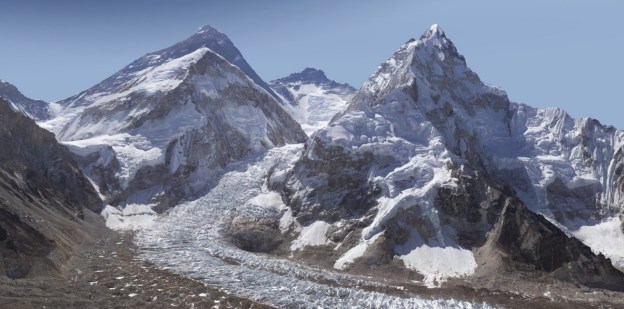 David Breashears is some guy. As if scaling Mount Everest five times wasn’t enough to be going on with, he’s also found time to snap enough photos to create a stunning two-gigapixel image of the world’s highest mountain and its surroundings.
David Breashears is some guy. As if scaling Mount Everest five times wasn’t enough to be going on with, he’s also found time to snap enough photos to create a stunning two-gigapixel image of the world’s highest mountain and its surroundings.
It’s a remarkable piece of work that allows you to zoom in to see the Himalayan landscape in incredible detail.
Filmmaker and climber Breashears used a camera with a 300mm lens to capture the 400 or so images that make up the panoramic photo. Mount Everest can be seen to the left of the middle of the stitched image.
“We’re so excited by that image,” Breashers said in a recent interview with National Public Radio’s Melissa Block. “I have myself climbed Everest five times and been to the mountain 15 times. And when I’m breathless at almost 18 or 19,000 feet recording these images, I have very little time to study the mountain and learn about it. And, of course, I can’t focus my eyes as closely as that lens can.” He said the incredibly detailed image now allows him to explore the area in “all its beauty and glory.”
Zoom in close enough and you can easily see individual tents and climbers at Base Camp. Other parts of the image show climbers on Mount Lhotse, the world’s fourth highest mountain.

“We can see climbers several miles away on the Lhotse face,” Breashears says. “Lhotse itself is over 28,000 feet high. And several thousand feet below its summit is Camp 3. And if you zoom in there, you can see not only the tents, but the little climbers – well, they’re little in the picture – making their way up to camp and to the higher camp.”
The image forms part of a project by the 57-year-old climber called GlacierWorks that aims to show the way the changing climate is affecting the Himalayan region. Breashears says when images shot today are compared with others taken in the first half of the last century, it’s clear to see the glaciers in the area are retreating. “There are over 49,000 glaciers throughout the greater Himalayan region, and most of them are showing dramatic and accelerated melt rate,” he told Block.
If you’ve always fancied a trip to the Himalayas but don’t have the winter wear or wherewithal, click here to explore an extraordinary image that will make you feel like you’re actually there.


